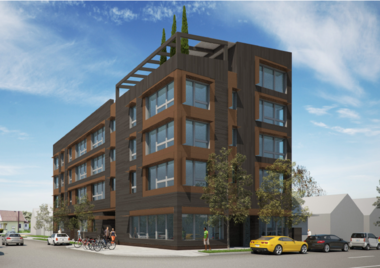
A proposed apartment without parking in Portland, Oregon. Via Oregon Live; Courtesy of the Boise Neighborhood Association
Mass transit and millennials are feeding one of the biggest trends in real estate development: apartments without a parking space included in the purchase price or rent.
Of course, city buildings constructed through World War II rarely had much parking. But starting in 1950, the number of parking spots built by home builders rose steadily for more than six decades, according to a study by real estate analysis firm Redfin.
Since 2012, however, the number of parking spots built per bedroom has declined. That’s causing some discussion over whether a lack of parking is good for the environment or bad for the neighborhood.
The issue is front and center in a number of American cities. Here’s a round-up of what’s going on where.
Last week, transportation officials in Portland, Oregon announced that they are looking into the possibility of building a subway system, according to Next City. That could increase demand for buildings without parking spaces.
In 2013, Portland officials decided that buildings with 30 units or more should have a minimum number of spaces, responding to neighbors’ complaints about crowded nearby streets. But in 2016, officials decided not to impose the minimums in a Northwest Portland neighborhood, reopening the debate.
In Denver, plans for an apartment building without onsite parking were approved in Denver last year, but were met with resistance from neighbors shortly afterwards, according to 9 News. The city has since stopped issuing similar permits for space-less buildings.
In Seattle, in downtown areas and near mass transit stops, 30 percent of proposed apartment developments in the past several years lack onsite parking, according to the Seattle Times. In addition, developers include 60 percent fewer parking spaces per unit than they did 10 years ago.
In Cleveland, the plan for an apartment building without onsite parking was approved last month, despite disapproval from community members, according to Cleveland.com.
Developers in Miami have been taking advantage of a zoning exemption that allows them to build apartment buildings without onsite parking near mass transit stops. A recent development is looking to create small — less than 400 square feet—units without parking, to make them affordable, according to the Miami Herald.
Chicago has recently cut back on requirements for onsite parking in apartment buildings near mass transit stops, noting that many parking spots sit empty, according to the Chicago Tribune.
Builders in Tacoma, Washington, are set to test the concept of “reduced parking area(s),” where the apartment buildings are not required to include onsite parking.
Boston has recently caught on to the trend. Earlier this month, two projects that lack onsite parking were approved, according to the Boston Globe. Yet in South Boston, where concerns over parking are prevalent, new rules will increase off-street parking requirements.
Despite the concerns over a lack of parking in Boston, city officials and developers are looking towards the future, and the future is the millennial generation.
“The need for one to one parking is obsolete,” Bruce Percelay, chairman of the Mount Vernon Company, told the Boston Globe. His firm is building an apartment house with more bike parking spots than car parking spots. “Millennials don’t even like to buy cars,” Percelay said.
Mass transit and millennials
Millennials, who are renting their first city apartments, and making plans to move to cities, are a factor in the trend. In 1983, about 89 percent of 19 year olds had driver’s licenses; in 2014, that percentage had dropped to 69 percent, according to a study done by the University of Michigan Transportation Institute.
There’s a debate over whether that trend shows a lack of interest in cars by millennials, born after 1982, or whether they aren’t at the point where they can afford to buy them.
Millennials are simply delaying buying cars, much as they are delaying buying homes, getting married and having kids, according to a Federal Reserve study. Although the percentage of cars purchased by millennials decreased overall from 2000 to 2015, millennials’ car purchases rose from 2010 to 2015, the Fed said.
In 2014, research company J.D. Power & Associates reported that millennials had passed Generation X in car buying. The report found that 67 percent of millennials surveyed thought that public transportation met most of their needs, although 64 percent of those who owned vehicles reported that they “loved” their cars.
Nevertheless, statistics regarding millennials buying cars are complicated. Some seem to contradict the predictions of developers building apartment buildings without any onsite parking, while others reinforce the ideas of developers.
It’s important to remember that these apartments are not just being rented or purchased by younger buyers. A number of empty nesters, singles and others are moving into cities, too.
No matter your situation, as you look for a perfect city loft, it’s likely that the place you shop for next may not have a space for your car.
— Micheline Maynard contributed to this story
